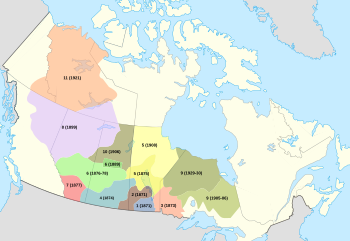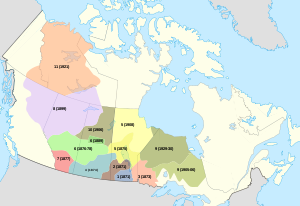| Numbered Treaties [17][18]
|
Signed On
|
Location
|
Major Treaty Signers
|
Those Effected
|
Brief Summary
|
| Treaty 1 |
August 1871 |
Lower Fort Gary , Fort Alexander |
Adams Archibald (Lieutenant Governor of Manitoba), Wemyss Simpson (Indian Commissioner) |
Chippewa Tribe, Swampy Cree Tribe, and all Indians inhabiting the district hereafter. |
First Nations Receive: Limited reserve land and monetary compensation, farming tools, education.
Canada Obtains: Land rights; promise of peace, law, and order, and restricted alcohol use on reserves
|
| Treaty 2 |
August 1871 |
Manitoba Post |
Adams Archibald (Lieutenant Governor of Manitoba), Wemyss Simpson (Indian Commissioner) |
Chippewa Tribe of Indians, and all Indians inhabiting the district hereafter. |
First Nations Receive: Limited reserve land and monetary compensation; farming tools; education.
Canada Obtains: Land rights; promise of peace, law, and order, and restricted alcohol use on reserves
|
| Treaty 3 |
October 1873 |
North-West Angle of the Lake of the Woods |
Alexander Morris (Lieutenant Governor), S.J Dawson (Indian Commissioner) |
The Saulteaux Tribe of the Ojibbeway Indians and all Indians inhabiting the district hereafter. |
First Nations Receive:Limited reserve land, and monetary compensation; farming tools; right to hunt and fish on succeeded land except that already used by Canada for resource extraction or settlement; schools on reserves.
Canada Obtains: Land rights; protection for land used for resource extraction or settlement from indigenous hunting/fishing, and restricted alcohol use on reserves
|
| Treaty 4 |
September 1874 |
Fort Qu'Appelle, Fort Ellice, Swan Lake, Fort Pelly, Fort Walsh
|
Alexander Morris (Lieutenant Governor), William J. Christie (Indian Commissioner) |
The Cree and Saulteaux Tribes of Indians, and all Indians inhabiting the district hereafter. |
First Nations Receive:Limited reserve land, and monetary compensation; farming tools; monetary allowance for gun powder, shot, bale, and fishing net twine totalling $750/year; right to hunt and fish on succeeded land except that already used by Canada for resource extraction or settlement; schools on reserves.
Canada Obtains: Land rights; protection for land used for resource extraction or settlement from indigenous hunting/fishing, and restricted alcohol use on reserves.
|
| Treaty 5 |
September 1875 (adhesions in February 1889) |
Beren's River, Norway House, Grand Rapids |
Alexander Morris (Lieutenant Governor), James McKay (Indian Commissioner) |
The Saulteaux and Swampy Cree Tribes of Indians, and all other Indians inhabiting the district hereafter. |
First Nations Receive: Limited reserve land, and monetary compensation; farming tools; monetary allowance for gun powder, shot, bale, and fishing net twine totalling $300/year; right to hunt and fish on succeeded land except that already used by Canada for resource extraction or settlement; schools on reserves when desired by First Nations, and deemed appropriate by Canada.
Canada Obtains: Land rights; protection for land used for resource extraction or settlement from indigenous hunting/fishing; restricted alcohol use on reserves; and full control of schooling on reserves.
|
| Treaty 6 |
28 August 1876 (adhesion 9 September 1876, and February 1889) |
Fort Carlton, Fort Pitt |
Alexander Morris (Lieutenant Governor), James McKay (Indian Commissioner), William J. Christie (Indian Commissioner) |
The Plain and Wood Cree Tribes of Indians, and all other Indians inhabiting the district hereafter. |
First Nations Receive:Limited reserve land, and monetary compensation; farming tools; monetary allowance for gun powder, shot, bale, and fishing net twine totalling $1500/year; right to hunt and fish on succeeded land except that already used by Canada for resource extraction or settlement; schools on reserves when desired by First Nations, and deemed appropriate by Canada; medicine chest clause is implemented; additional assistance is available for pestilence or famine relief
Canada Obtains: Land rights; protection for land used for resource extraction or settlement from indigenous hunting/fishing; restricted alcohol use on reserves; control of healthcare on reserves through the medicine chest initiative.
|
| Treaty 7 |
September 1877 |
"Blackfoot Crossing" of the Bow River, Fort McLeod |
David Laird (Government Official), James F. MacLeod (Indian Commissioner), |
The Blackfoot, Blood, Piegan, Sarcee, Stony, and all other Indians inhabiting the district hereafter. |
First Nations Receive:Limited reserve land, and monetary compensation; farming tools; monetary allowance for ammunitition totalling $2000/year; right to hunt and fish on succeeded land except that already used by Canada for resource extraction or settlement; have right to build and maintain infrastructure on reserves; salary is allocated to hire a school teacher for reserve school.
Canada Obtains: Land rights; protection for land used for resource extraction or settlement from indigenous hunting/fishing; restricted alcohol use on reserves.
|
| Treaty 8 |
8 July 1899 (adhesions until 1901) |
Lesser Slave Lake, Peace River Landing, Vermillion, Fond du Lac, Dunvegan, Fort Chipewyan, Smiths Landing, Fort McMurray, Wapiscow Lake |
David Laird (Treaty Commissioner), J.H. Ross (Treaty Commissioner), J.A.J McKenna (Treaty Commissioner) |
The Cree, Beaver, Chipewyan, and all other Indians inhabiting the district hereafter. |
First Nations Receive:Limited reserve land, and monetary compensation; farming tools; monetary allowance for ammunition and fishing net twine totalling $1 per family head; right to hunt and fish on succeeded land except that already used by Canada for resource extraction or settlement; money is set aside to hire school teachers as needed.
Canada Obtains: Land rights; protection for land used for resource extraction or settlement from indigenous hunting/fishing; restricted alcohol use on reserves; ability to buy and sell aboriginal land with their consent.
|
| Treaty 9 |
6 November 1905 |
Osnaburg, Fort Hope, Marten Falls, Fort Albany, Moose Factory, New Post, Abitibi, Matachewan, Mattagami, Flying Post, New Brunswick House, Long Lake |
Duncan Campbell Scott (Treaty Commissioner), Samuel Stewart (Treaty Commissioner), Daniel G. MacMartin |
The Ojibway, Cree, and all other Indians inhabiting the district hereafter. |
First Nations Receive:Limited reserve land, and monetary compensation; farming tools; monetary allowance for ammunition and fishing net twine totalling $1 per family head; right to hunt and fish on succeeded land except that already used by Canada for resource extraction or settlement; funds to hire teachers, construct schools, and purchase supplies are available, but with Canada's authorization.
Canada Obtains: Land rights; protection for land used for resource extraction or settlement from indigenous hunting/fishing; restricted alcohol use on reserves; full control funds for education.
|
| Treaty 10 |
7 November 1906 |
Isle à la Crosse, Lac du Brochet |
J.A.J McKenna (Treaty Commissioner) |
The Chipewyan, Cree, and all other Indians inhabiting the district hereafter. |
First Nations Receive:Limited reserve land, and monetary compensation; farming tools; right to hunt and fish on succeeded land except that already used by Canada for resource extraction or settlement; unspecified amount of ammunition and twine distributed as government sees fit; provision for childhood education; furnishings for agricultural assistance
Canada Obtains: Land rights; protection for land used for resource extraction or settlement from indigenous hunting/fishing; restricted alcohol use on reserves; control of the allocation of ammunition and fishing twine, and the distribution of agricultural assistance.
|
| Treaty 11 |
27 June 1921 until 22 August 1921 |
Northwest Territories Providence, Simpson, Wrigley, Norman, Good Hope, Arctic Red River, McPherson, Liard, Rae |
Duncan Campbell Scott (Governor General/Major Signer), Henry Anthony Conroy (Indian Commissioner) |
The Slave, Dogrib, Loucheux, Hare, and other Indians, inhabitants of the territory within the limits hereinafter |
First Nations Receive: Limited reserve land, and monetary compensation; farming tools; right to hunt and fish on succeeded land except that already used by Canada for resource extraction or settlement; provision for childhood education; furnishings for agricultural assistance; have right to build and maintain infrastructure on reserves; provision for childhood education; each family receives 50$ annually for fishing twine and trapping; distribution of agricultural assistance possible.
Canada Obtains: Land rights; protection for land used for resource extraction or settlement from indigenous hunting/fishing; restricted alcohol use on reserves; ability to buy and sell aboriginal land with permission; control of the allocation of ammunition and fishing twine, and the distribution of agricultural assistance.
|

